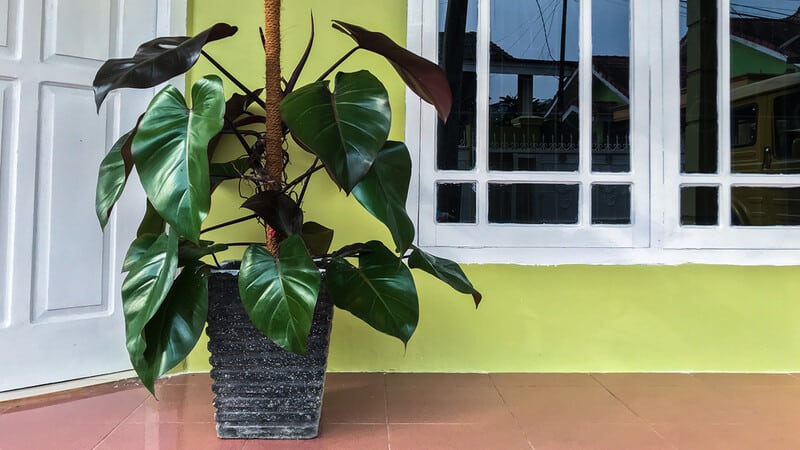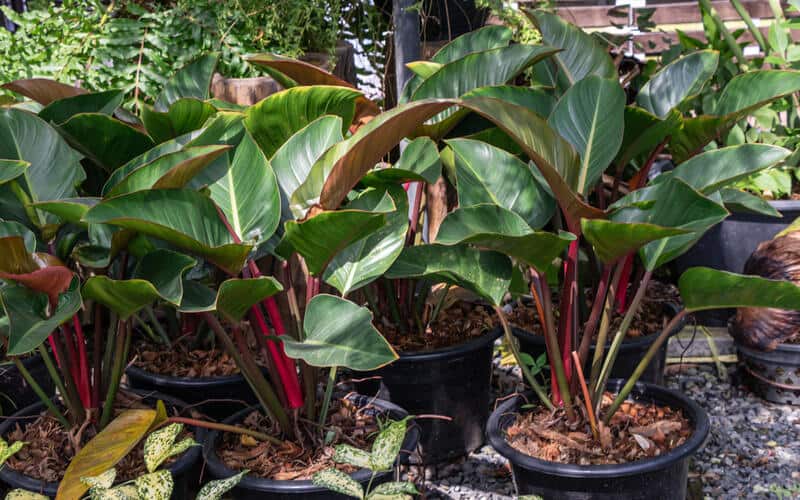Growing a Philodendron Erubescens is easy — almost too easy, in fact!
With proper care, it won’t be long before the height of this fast-growing Philodendron will reach your ceiling. The Erubescens variety is as beautiful as it is low-maintenance.
When it is fully grown, the plant’s lance-shaped foliage creates a cascading effect.
It’s no wonder the Erubescens variety is popular among plant lovers — its dramatic form is unlike any other.
Can’t wait to start building your very own green oasis at home? Here’s how to transform your indoor space from ordinary to Insta-worthy with the ever-exquisite Philodendron Erubescens.
The Philodendron Erubescens: a quick overview
One look at the Philodendron Erubescens and you’ll know this one’s a keeper: the Erubescens is known for its large glossy heart shaped leaves that are dark green and burgundy in colour.
This towering beauty from the Araceae family can grow between 3 to 6m in height, depending on its environment.
It usually takes about 5 years for an Erubescens to reach full maturity — by then, you’ll have a beautiful vining houseplant that’s ready to propagate.
Philodendron Erubescens varieties
The Philodendron Erubescens is called the blushing philodendron because of its dazzling appearance.
Without a doubt, the wine red tinge on its foliage makes it a standout among indoor plants.
The Philodendron Erubescens is a native plant from South America, but later propagation gave way to the emergence of other Philodendron cultivars in other parts of the world.
When grown in its natural habitat, the Erubescens produces beautiful deep red flowers.
These are some of the cultivated varieties of the Erubescens:
- Philodendron Pink Princess
- Philodendron Erubescens Ruby
- Philodendron Erubescens Imperial Red
- Philodendron Erubescens Red Emerald
- Philodendron Erubescens Green Emerald
- Philodendron Erubescens Gold
The Philodendron Erubescens Red Emerald is known for its red petiole, midrib and veins.
While the Pink Princess has playful pink variegations, the Red Emerald has an unmistakably dramatic burgundy colour.
There is much debate about the Green Emerald vs the Red Emerald varieties, but the colouring all boils down to the amount of sunlight and shade that your plant receives.
The Red Emerald and Imperial Red may look similar at first glance, but if you look closely, you’ll notice that the Red Emerald is a climbing variety.
The Imperial Red, on the other hand, is a self-heading plant much like the Pink Princess.
Philodendron Erubescens care
The Philodendron Erubescens is the perfect indoor plant for beginners and busy plant parents.
For one, you get an attractive Philodendron with unique colouring, and caring for it is practically fuss-free. As an added plus, the Philodendron Erubescens does not even require plenty of bright, direct sunlight.
If your house or apartment is not particularly flooded with natural light, the Erubescens is the ideal plant for you.
These are the things you need to know when caring for a Philodendron Erubescens:
Light requirements
Unlike other Philodendron varieties that thrive in bright, indirect light, the Philodendron Erubescens prefers medium indirect light. T
ake care not to avoid sunlight altogether, however. Insufficient light can cause your Philodendron to have leggy stems.
Avoid positioning your plant in a south facing window to prevent the leaves from getting scorched.
Yellowing leaves is also a sign that your plant is getting too much bright, direct sunlight. As a general rule of thumb, northern and eastern facing windows work best for your Erubescens.
Pro tip: Giving your plant the right amount of sunlight is like a delicate balancing act — too much light can scorch the leaves of your Philodendron.
Too little light, on the other hand, will cause your plant to lose its beautiful red markings.
If you’re unsure which is the best position for your plant, consult with your local gardening professionals for suggestions. This way, you know you’re giving your Erubescens the best plant care possible.
Water
When it comes to watering your Erubescens, underwatering is better than overwatering. Philodendrons dislike too much water, in general, and can develop root rot when they get waterlogged.
You’ll know when your plant is overwatered when the leaves turn yellow. Avoid watering too frequently, or too much.
Don’t fret if you miss a watering session or two — your plant baby will still survive as long as there’s some moisture in the soil.
To test for moisture, stick your finger into the soil. It should feel moist but not soggy. When the soil feels dry, that’s your signal to water your plant again.
Pro tip: Your Erubescens may not be such a big fan of liquid, but it doesn’t like to be completely dry either.
Take care not to let it get dehydrated in between waterings — even just a little moisture in the soil can mean the difference between a thriving Philodendron and a wilted one.
Soil
Well-draining soil that is enriched with organic matter and perlite is the best planting mix for your Erubescens.
For soil that has a high clay content, loosen it with sand to allow more air into the soil.
Humidity levels
Philodendrons thrive best in humid conditions. When grown in an environment with high humidity, their leaves and stems become plump and healthy-looking. Low humidity causes your Erubescens to look droopy and weak.
There are many ways to increase the humidity levels in your Philodendron’s environment.
One method is to use a pebble tray with water. Simply replenish the water when all of the moisture has evaporated.
Grouping Philodendrons together also gives your plants some much-needed humidity. It’s also a great way to bulk up the look of your plants and create a botanical focal point in your home.
Pro tip: Try our favourite trick when growing Philodendrons — place them in the bathroom! This is the quickest — and easiest — way to give your plant a humid environment.
Bathrooms are the most humid area in any home and are perfect for mimicking the conditions in a rainforest (also known as the natural habitat of Philodendrons).
Temperature
The Erubescens is not as cold- and drought-tolerant as other Philodendron varieties.
A moderate room temperature of about 15 to 28C is just about right for your Philodendron Erubescens.
Fertilising
While your Philodendron Erubescens is a fast grower, it can still benefit from a monthly fertilising.
A well-fertilised plant will continue to produce large, healthy-looking leaves and will be more disease-resistant than its under-fertilised counterpart.
Use a balanced indoor plant food that is well-suited to your Philodendron.
Support
The Erubescens is a fast-growing Philodendron variety. This climber works best when attached to a trellis or any structural support.
When grown to its full height, these fiery redheads can reach 6m tall.
Pruning
Pruning a Philodendron Erubescens is done to manage its shape and size.
Remove any leggy stems and cut off any yellowing leaves to maintain your plant’s robust form.
Toxicity
When growing an Erubescens indoors, take care not to let pets or little kids ingest any part of the plant. Tempting as it looks, this variety is toxic to both humans and animals.
The Erubescens has calcium oxalate crystals that are known to be a skin irritant.
Common problems
Foliage pests and diseases are common in Philodendrons. Watch out for scale and mealybugs on new growth.
Discoloured leaves and leaf mottling — a type of leaf distortion when the leaf growth is stunted — can signal the presence of spider mites.
Pro tip: A healthy Philodendron is your best ally against pest infestation and disease.
Make sure that your plant is receiving sufficient light, humidity, and moisture to keep it resistant to disease and pests.
How to propagate Philodendron Erubescens
With everything going on for the Philodendron Erubescens, it’s hard not to fall in love with it.
There’s no need to keep on buying, though. You can propagate these Philodendrons at home, and it’s super easy to do.
To grow an Erubescens from an existing plant, all you need to do is get a cutting with one or two nodes on the stem.
Place the cutting in water and wait for the roots to grow out of the nodes — this can take several weeks or months.
As soon as the roots are long enough (several cm long is just about right), you can transplant your cutting into your planting mix.
Any well-draining potting mix will do. If the soil is too dense, you can loosen it with perlite and sand.
Allow your new plant to grow into its new home — and avoid overwatering at all costs to prevent root rot.
There you have it, your very own Philodendron Erubescens!






